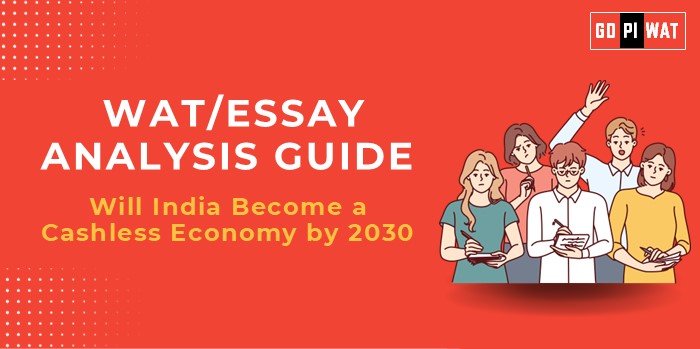📋 Will India Become a Cashless Economy by 2030?
🌐 Introduction to the Topic
Opening Context: “India has witnessed a significant surge in digital payments,
with the Unified Payments Interface (UPI) processing over 11.5 billion transactions monthly as of
March 2024, indicating a strong move toward a cashless economy.”
Topic Background: The push toward a cashless economy gained momentum post-2016
demonetization, leading to the proliferation of digital payment platforms like UPI. Government
initiatives, including Digital India and financial inclusion programs, have further accelerated
this transition.
📊 Quick Facts and Key Statistics
- 📈 UPI Transactions (March 2024): 11.5 billion transactions per month, reflecting widespread adoption.
- 💰 Digital Payment Value (March 2024): ₹17.5 lakh crore monthly, showcasing the economic scale of digital transactions.
- 🌍 Internet Users (2024): Approximately 900 million, indicating substantial digital penetration.
- 🌾 Rural Internet Access (2023): India has expanded significantly, with rural areas accounting for 53% of the country’s internet users.
- 🎓 Digital Literacy Program (PMGDISHA): Trained over 6.7 crore citizens, aiming to bridge the digital literacy gap.
🤝 Stakeholders and Their Roles
- 🏛️ Government of India: Formulates policies, provides regulatory frameworks, and invests in digital infrastructure projects like BharatNet.
- 🏦 Reserve Bank of India (RBI) and NPCI: Oversee and innovate payment infrastructures, including UPI and the e-RUPI voucher system.
- 💼 Private Sector (Banks & Fintechs): Drive financial innovation and expand the reach of digital payment solutions.
- 👥 Citizens: Adopt and integrate digital payment methods into daily transactions.
- 🌐 International Organizations: Provide guidance and support for best practices in developing digital economies.
🏆 Achievements and ⚠️ Challenges
🏆 Achievements
- 📊 UPI’s Widespread Adoption: Over 11.5 billion transactions monthly as of March 2024, indicating robust growth.
- 💳 Financial Inclusion Efforts: Opening of over 47 crore Jan Dhan accounts, facilitating digital transactions for the unbanked population.
- 📂 Digital Governance Initiatives: More than 400 million users registered on DigiLocker, promoting paperless governance.
⚠️ Challenges
- 🌐 Digital Divide: Only 20% of rural households have internet access, limiting digital payment adoption.
- 🔐 Cybersecurity Concerns: Incidents like the AIIMS cyberattack highlight vulnerabilities in digital infrastructure.
- 💵 Cash Dependency in Rural Areas: High reliance on cash transactions due to limited digital infrastructure and literacy.
🌎 Global Comparisons
- 🇪🇪 Estonia: Pioneered e-governance with a high degree of digital service integration.
- 🇸🇬 Singapore: Achieved significant success in digital payments through robust infrastructure and inclusive policies.
🗨️ Structured Arguments for Discussion
- 👍 Supporting Stance: “India’s exponential growth in digital payments, exemplified by UPI’s success, positions it well to become a cashless economy by 2030.”
- 👎 Opposing Stance: “Persistent digital divides, cybersecurity threats, and cultural preferences for cash transactions may impede India’s transition to a cashless economy by 2030.”
- ⚖️ Balanced Perspective: “While India’s digital payment infrastructure has advanced significantly, achieving a cashless economy by 2030 will require addressing rural connectivity issues, enhancing cybersecurity, and fostering digital literacy.”
💡 Effective Discussion Approaches
- 🔍 Opening Approaches:
- “India’s digital payment transactions have surpassed those of many developed nations, yet rural areas remain predominantly cash-dependent.”
- “The rapid adoption of UPI reflects urban India’s readiness for a cashless economy, contrasting with the challenges faced in rural regions.”
- 🛡️ Counter-Argument Handling:
- Acknowledge the digital divide and propose solutions such as expanding BharatNet to improve rural connectivity.
- Highlight government initiatives aimed at enhancing digital literacy and cybersecurity measures.
📋 Strategic Analysis of Strengths and Weaknesses
🌟 Strengths
- Robust digital payment platforms like UPI.
- Strong government support and policy initiatives.
- Growing fintech ecosystem fostering innovation.
🛠️ Weaknesses
- Limited internet penetration in rural areas.
- Cybersecurity vulnerabilities.
- Cultural preference for cash transactions in certain demographics.
📈 Opportunities
- Integration of emerging technologies such as 5G to enhance digital infrastructure.
- Public-private partnerships to expand digital payment reach.
- Educational programs to boost digital literacy.
⚠️ Threats
- Rising incidents of digital fraud and cyberattacks.
- Resistance to change among cash-dependent populations.
- Potential regulatory challenges affecting fintech operations.
📚 Connecting with B-School Applications
- Real-World Applications:
- Analyzing the impact of digital payments on financial inclusion and economic growth.
- Exploring the role of fintech in transforming traditional banking systems.
- Sample Interview Questions:
- “What strategies can be implemented to increase digital payment adoption in rural India?”
- “How can cybersecurity be strengthened to support India’s transition to a cashless economy?”
- Insights for B-School Students:
- Understanding the interplay between technology, policy, and consumer behavior in financial systems.
- Recognizing the importance of inclusive growth in digital transformation initiatives.


